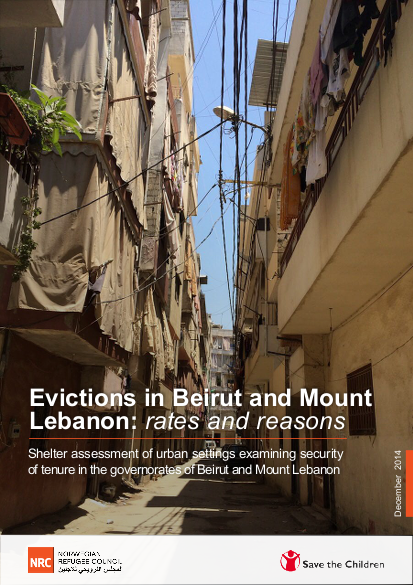Shelter assessment of urban settings examining security of tenure in the governorates of Beirut and Mount Lebanon

As the Syria response enters its fourth year, Lebanon hosts the highest number of refugees per capita globally. While the response to date has largely targeted the North, Bekaa Valley, and the South, analysis of UNHCR’s registration data shows that Beirut and Mount Lebanon is the governorate with the most rapid growth in registered refugee population. Most of this growth is focused in the urbanised area of greater Beirut. Moreover, UNICEF and UNHCR’s mapping of registered refugees and host community vulnerability demonstrates that many of the most extremely vulnerable cadastres are in the Greater Beirut area.
In a context where 81% of refugees pay rent for their accommodation, and on average 57% live in finished apartments and houses security of tenure and rates of evictions are of particular concern. One UNHCR figure put the estimate of the total rent paid by Syrian households at USD 74 million per month This, compounded with limited livelihood options and additional costs for essential items and services, results in significant household expenditures.
While information on evictions does exist, both anecdotal and quantifiable, at the time of this assessment there was limited information on security of tenure and rates of evictions in the rental market for finished apartments in Beirut and Mount Lebanon. The objectives of the assessment were: to better understand the situation amongst Syrian refugees renting finished apartments; to identify statistically relevant variables associated with security of tenure and evictions; and to contribute to the on-going dialogue on response options to urban environments.
Resource collections
- Evaluating humanitarian action
- UN Habitat - Urban Response Collection
- Urban Response - Urban Crisis Preparedness and Risk Reduction
- Urban Response Collection - Community Engagement and Social Cohesion
- Urban Response Collection - Economic Recovery
- Urban Response Collection - Environment and Climate Change
- Urban Response Collection - Housing, Land and Property
- Urban Response Collection - Urban Crisis Response, Recovery and Reconstruction
- Urban Response Collection - Urban Resilience